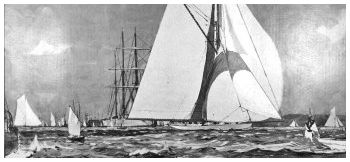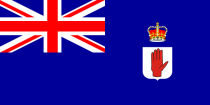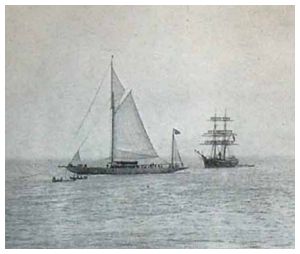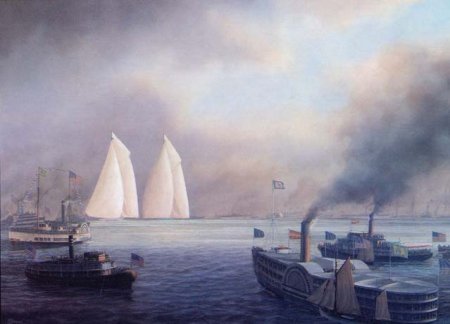Yves GARY Hits: 5999
Category: SHAMROCK
 When Lipton decided to challenge he was content with no half-way measures, and gave designer Fife a carte blanche order to spare no expense, but to turn out the fastest boat that money could produce.
When Lipton decided to challenge he was content with no half-way measures, and gave designer Fife a carte blanche order to spare no expense, but to turn out the fastest boat that money could produce.
Shamrock was built by the Thorney crofts, at Mill wall on the Thames, near London. The greatest secrecy was observed in construction. Shamrock was launched June 24th, 1899.
 Published: May 14, 1899 |
YACHTING |
 Published: June 16, 1899 |
DESCRIPTION OF THE SHAMROCK. |
 Published: June 27, 1899 |
COLUMBIA AND SHAMROCK. |
 Published: June 27, 1899 |
CUP CHALLENGER SAFELY LAUNCHED |
 Published: June 27, 1899 |
TUG BUMPS INTO SHAMROCK. |
 Published: June 27, 1899 |
THE LAUNCHING OF THE SHAMROCK |
 Shamrock's lines have never been published. She combined some of the features of Britannia * with those of Defender. She was not so wide as the challenger that preceded her, Valkyrie III, by a foot, but was finer, and more powerful, while her spar-plan was designed for a great spread of canvas.
Shamrock's lines have never been published. She combined some of the features of Britannia * with those of Defender. She was not so wide as the challenger that preceded her, Valkyrie III, by a foot, but was finer, and more powerful, while her spar-plan was designed for a great spread of canvas.
After a long period of development, Shamrock only two races compete against Britannia for his preliminary tests.
 Published: July 13, 1899 |
THE SHAMROCK HAS SUSTAINED NO INJURIES |
 Published: July 16, 1899 |
THE SHAMROCK TAKES A SPIN ON A CHOPPY SEA. |
 Published: July 19, 1899 |
CUP CHALLENGER BEATS BRITANNIA. |
 Published: July 19, 1899 |
THE SHAMROCK EASILY BEATS THE BRITANNIA. |
 Published: July 20, 1899 |
SHAMROCK AGAIN A WINNER |
 Published: July 20, 1899 |
THE SHAMROCK TOO FAST FOR THE BRITANNIA. |
 Shamrock came to this country under reduced cutter rig, convoyed by the steam-yacht Erin. Permission was granted by the New York Yacht Club to tow Shamrock in calm weather, and under tow most of the way she made the passage from Fairlee, which was left August 3d, to Sandy Hook, via the Azores, in fourteen days twenty hours, the distance being three thousand four hundred miles.
Shamrock came to this country under reduced cutter rig, convoyed by the steam-yacht Erin. Permission was granted by the New York Yacht Club to tow Shamrock in calm weather, and under tow most of the way she made the passage from Fairlee, which was left August 3d, to Sandy Hook, via the Azores, in fourteen days twenty hours, the distance being three thousand four hundred miles.
 Published: August 18, 1899 |
THE SHAMROCK ARRIVES |
On her arrival here Shamrock was rigged promptly for racing, and was given several trials off Sandy Hook, in which she appeared to be a veritable witch in light airs. On September 13th she met with an accident, her steel gaff buckling until it collapsed. It may be mentioned here that her spars and gear were too light for her sails, which defect caused a loss of speed. She was finely handled by Capt. Archie Hogarth, assisted by Capt. Robert Wringe.
 Published: September 14, 1899 |
SHAMROCK'S GAFF BREAKS |


- from 3 au 20 october 1899, at New York.
- the contest was to be decided by the winning three races out of five.
- the first, third and fifth races to be to windward and leeward, the second and fourth over a triangle, all courses to be thirty miles, and laid to windward when possible.
- the starts to be from Sandy Hook light-vessel.
- starting signals to be given at 11 o'clock, and delayed only in event of changing the starting-point, fog, or agreed postponement; preparatory gun to be fired ten minutes before starting signal, and handicap gun two minutes after
- time limit for races five and a half hours.
- vessels to be allowed time for repairs in case of an accident.
- yachts to be measured with all weights on board to be carried in a race, restrictions as to bulkheads, floors, doors, water-tanks and anchor being waived.
- the water-line should be marked at the bow and as far aft as possible, on each vessel.
Shamrock, the challenger of Royal Ulster Yacht Club, is confronted to Columbia.
Four races postponed : lack of wind or fog.
Four races canceled : time limit.
Three regattas are raced. Columbia beat Shamrock, three wins to nil.
- October 16, 1st race, 30 miles, windward-leeward : Columbia beat Shamrock by 10 mn 8 s corrected time.
- October 17, 2nd race, 30 miles, triangle : Shamrock's topmast broken. Columbia wins.
- October 20, 3rd race, 30 miles, windward-leeward : Columbia beat Shamrock by 6 mn 34 s corrected time after a race of anthology.

On November 2, 1899, Shamrock leaves New York and is towed back to Great Britain by Lipton's steam yacht, Erin, via the Azores. It is dry-docked on arrival.
In 1901 Shamrock I is refitted by Lipton and sails as a trial horse for his new challenger, Shamrock II, a George L. Watson design.
In April 1903, Shamrock is refitted again and sails as a trial horse for Shamrock III. On May 28, 1903, with 41 crewmen onboard, Shamrock I sails to New York and races against Shamrock III before the Cup. After the Cup, Lipton tries to sell his two yachts, without success.
